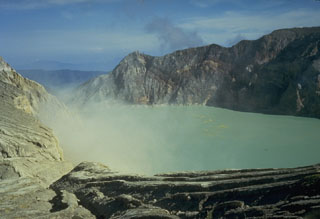Report on Ijen (Indonesia) — October 2000
Bulletin of the Global Volcanism Network, vol. 25, no. 10 (October 2000)
Managing Editor: Richard Wunderman.
Ijen (Indonesia) Low-medium density ash emission; elevated seismicity with continuous tremor
Please cite this report as:
Global Volcanism Program, 2000. Report on Ijen (Indonesia) (Wunderman, R., ed.). Bulletin of the Global Volcanism Network, 25:10. Smithsonian Institution. https://doi.org/10.5479/si.GVP.BGVN200010-263350
Ijen
Indonesia
8.058°S, 114.242°E; summit elev. 2769 m
All times are local (unless otherwise noted)
This report covers the period June-October 2000. During mid-June, seismographs recorded an increasing number of earthquakes. A white, variable-density ash plume rose 25 m above Ijen's summit. Volcanic and tremor earthquakes occurred with amplitudes of ~0.5-4 mm. In late July, the number of volcanic and tremor earthquakes increased.
Ash erupted once during late August-early September. A medium-density ash cloud rose up to 50 m above the crater during the second week in September. The following week, the ash emission changed to a low-density plume and rose 25 m.
In late September, seismographs registered an increase in shallow volcanic (B-type) earthquakes and the initiation of continuous tremor. Visual observations were not available for late September and parts of October because of inclement weather. Tremor became discontinuous by the end of October, and elevated seismicity continued.
Geological Summary. The Ijen volcano complex at the eastern end of Java consists of a group of small stratovolcanoes constructed within the 20-km-wide Ijen (Kendeng) caldera. The north caldera wall forms a prominent arcuate ridge, but elsewhere the rim was buried by post-caldera volcanoes, including Gunung Merapi, which forms the high point of the complex. Immediately west of the Gunung Merapi stratovolcano is the historically active Kawah Ijen crater, which contains a nearly 1-km-wide, turquoise-colored, acid lake. Kawah Ijen is the site of a labor-intensive mining operation in which baskets of sulfur are hand-carried from the crater floor. Many other post-caldera cones and craters are located within the caldera or along its rim. The largest concentration of cones forms an E-W zone across the southern side of the caldera. Coffee plantations cover much of the caldera floor; nearby waterfalls and hot springs are tourist destinations.
Information Contacts: Dali Ahmad, Volcanological Survey of Indonesia (VSI), Jalan Diponegoro No. 57, Bandung 40122, Indonesia (URL: http://www.vsi.esdm.go.id/).

